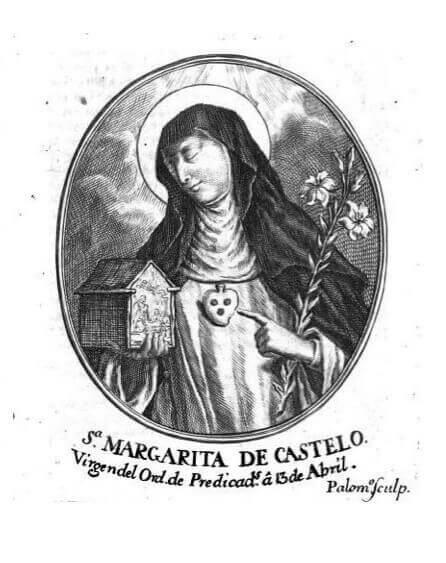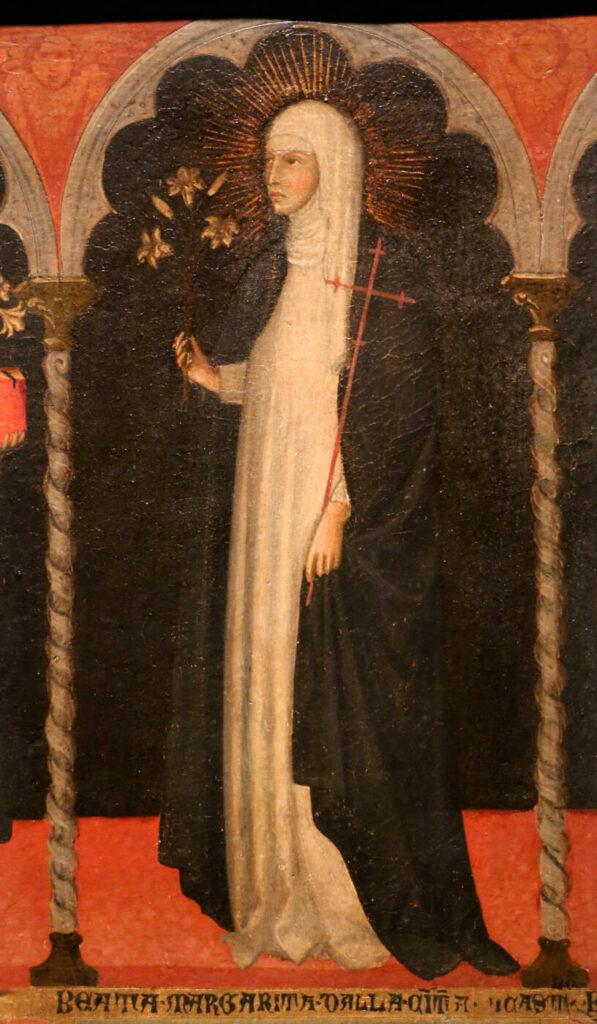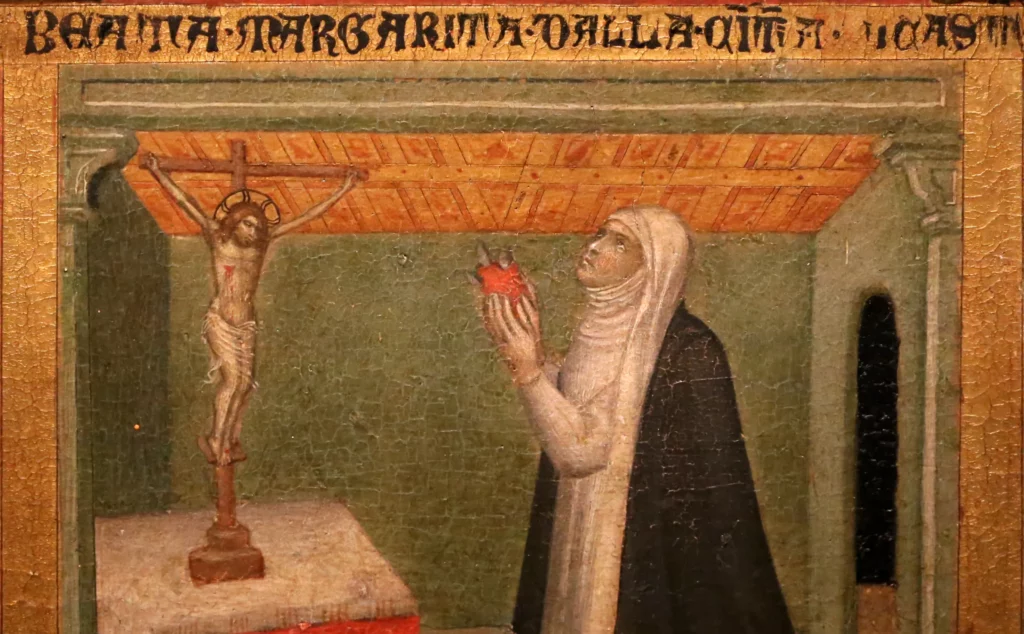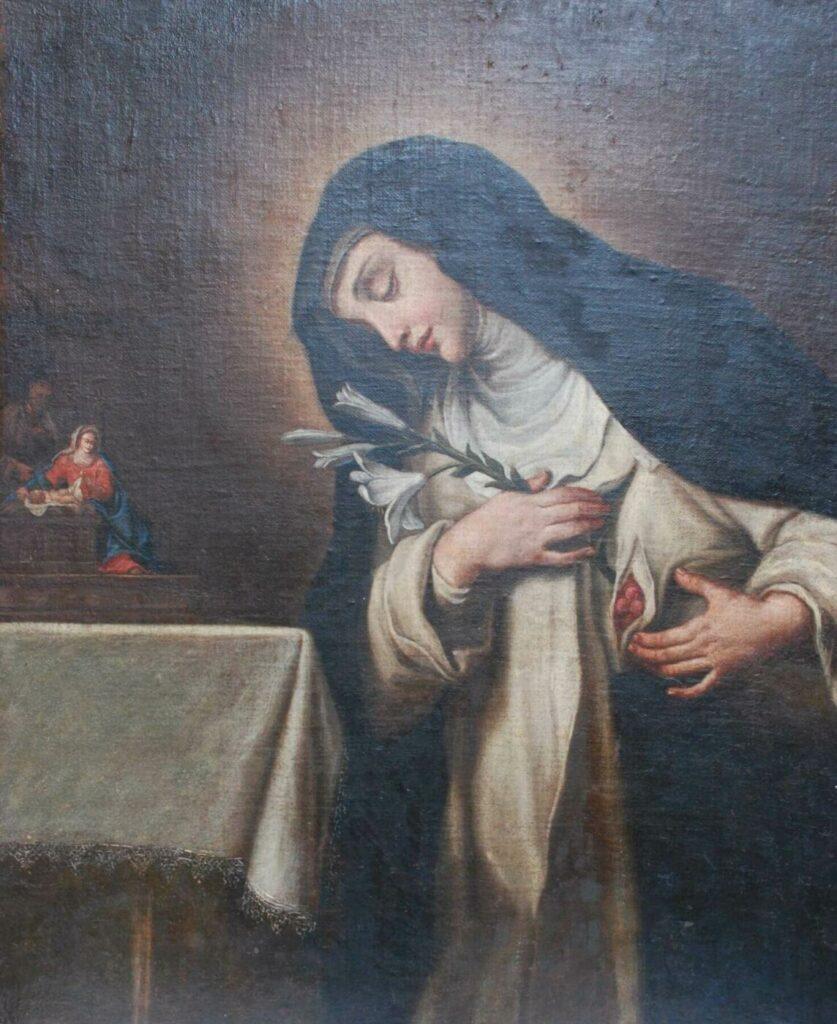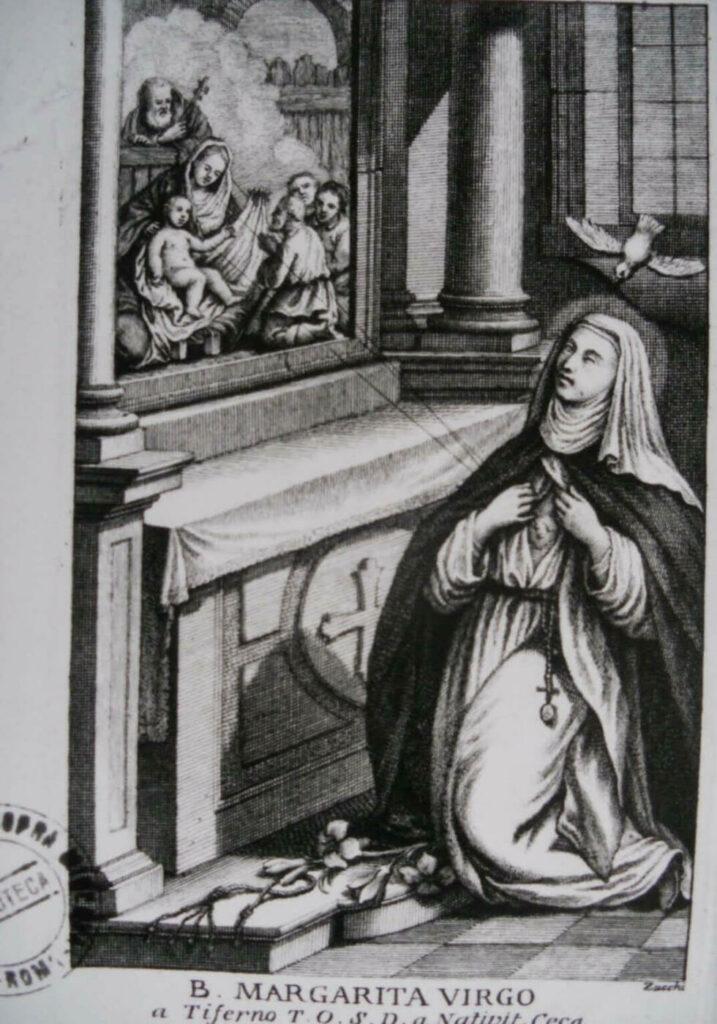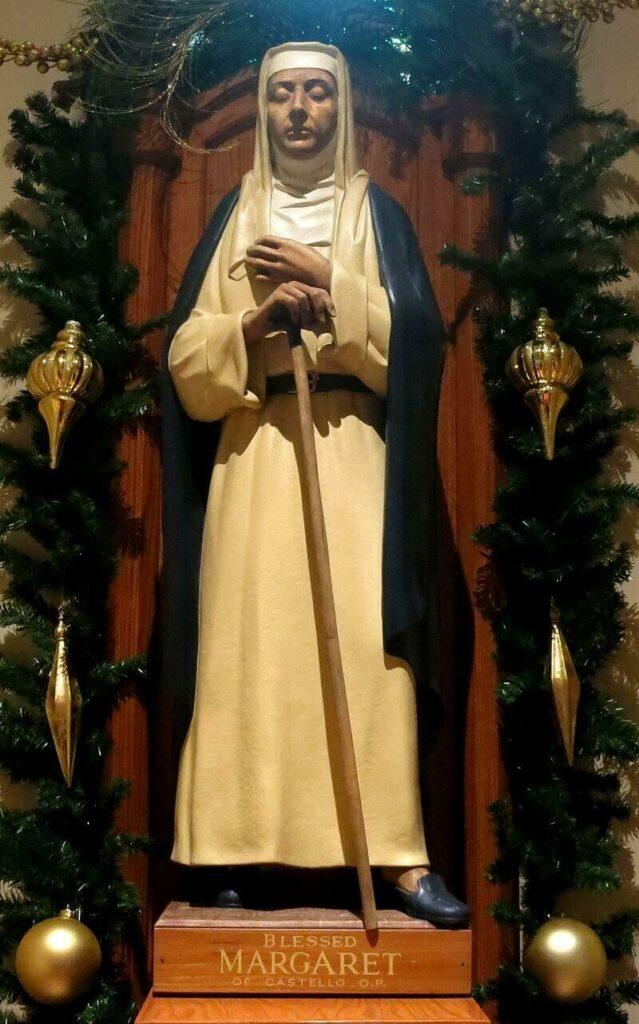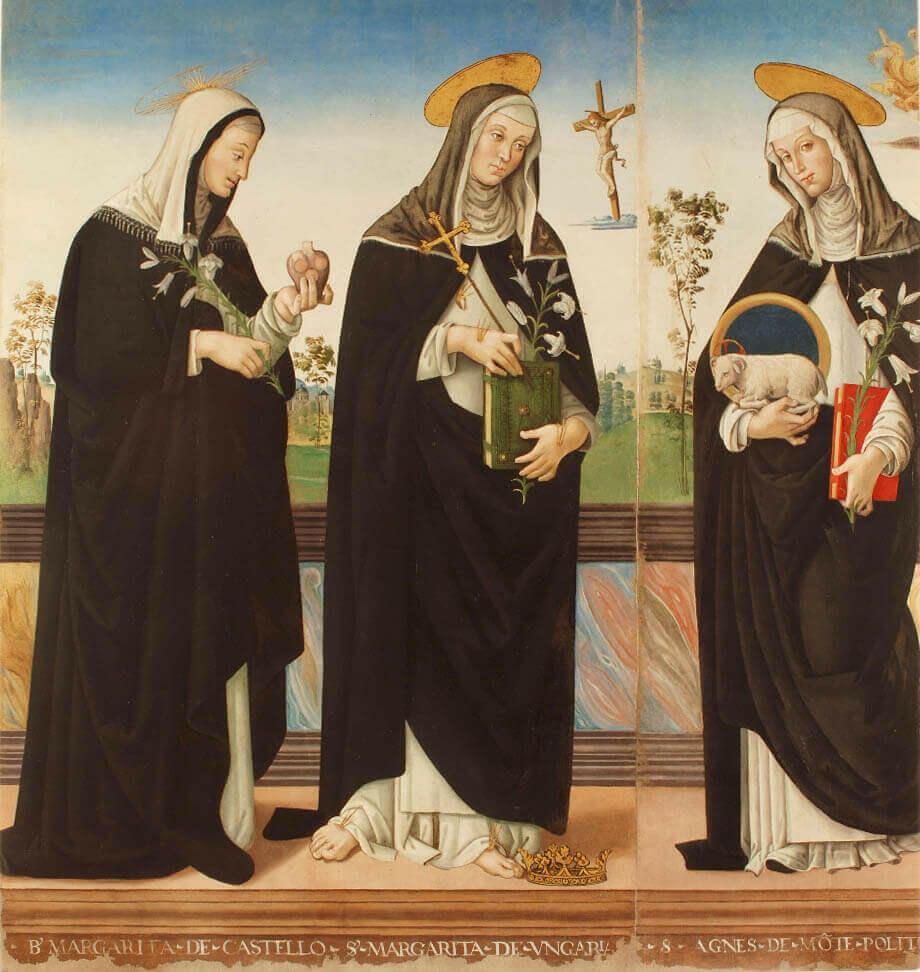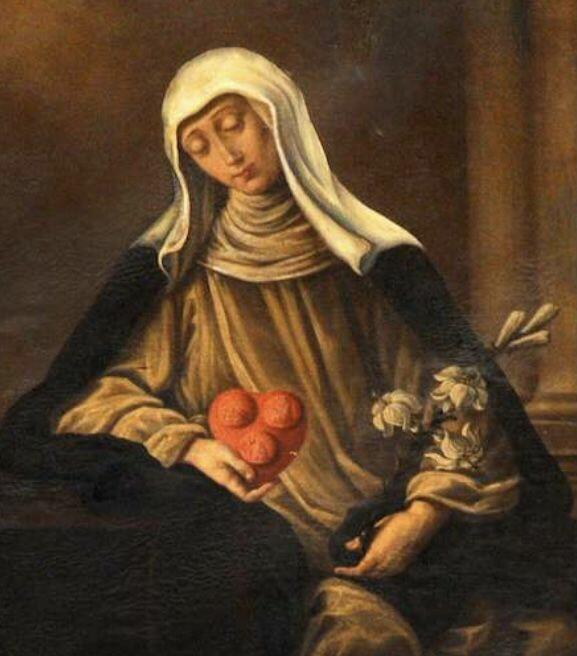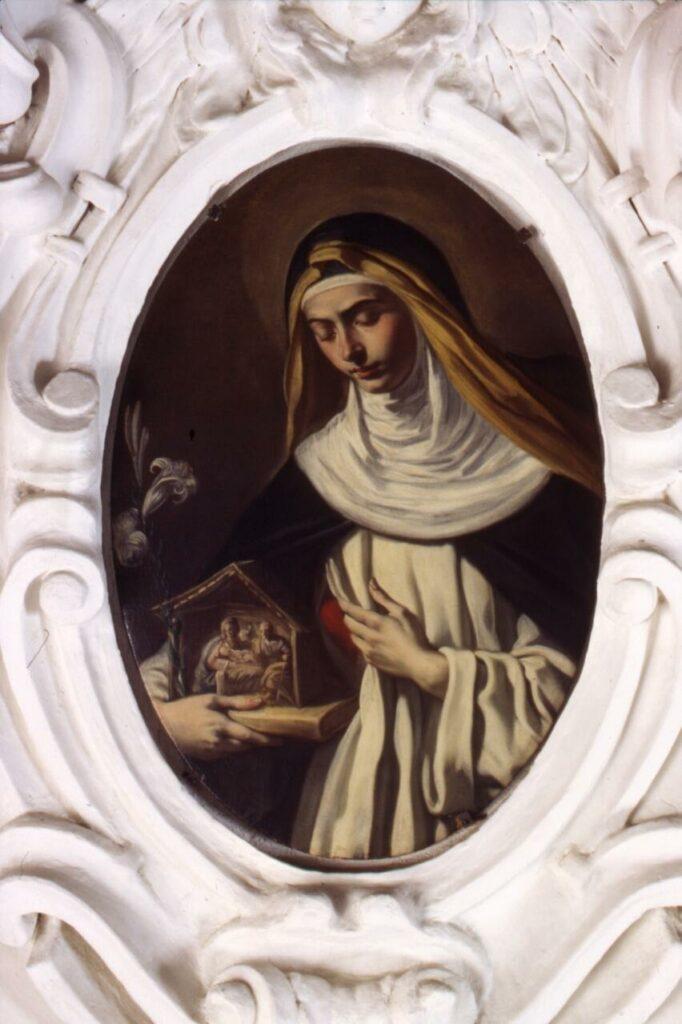Saint Margherita of Città di Castello or Metola
The Disabled Saint
The Disabled Saint
The Saint Margherita
The human and spiritual story of Saint Margherita of Città di Castello, after seven centuries, still has much to say and teach.
First of all, Margherita’s story reminds us that God does not abandon anyone, and therefore we must not forget those who are in need either.
The dramatic story of Saint Margherita helps us to monitor the dangers for the future of humanity
The life of Saint Margherita
Birth and early years
The year of the birth of Saint Margherita of Città di Castello is commonly dated back to 1287.
Starting from the year of her death, 1320, considering that she was 33 years old at that time, we went back to 1287.
In reality, the fourteenth-century biographies do not say that at the time of her death Margherita di lei was 33 years old: it is an interpretation shared by all scholars, but it is not documented.
Saint Margherita of Città di Castello was born in the castle of Metola or della Metola in the Massa Trabaria, daughter of the “cattano” of the Metola area, named Parisio and his wife Emilia.
She was one of the local lords who emerged victorious from one of the many fights with neighboring towns for the dominion of Massa Trabaria, but we know almost nothing about him.
Her noble parents were expecting an heir but had a bitter surprise when, at the moment of her birth, they realized that she had been born a very small girl, with a hump and a shorter right leg.
As if that wasn’t enough, after a short time they realized that Margherita was also blind.
The anonymous author of Life Long writes about Margherita:
“They (the parents), having seen this blind, small and deformed daughter of theirs, struck by immense pain, began to hate her, while the angels, seeing her in heaven bright, beautiful and pleasing to God, instantly took her under their custody; and so divine goodness decided to console the one that the world had begun to despise.
In fact, she is born without bodily eyes so as not to see the world, but she is satisfied with the divine light so that, while on earth, she can only contemplate the sky.
She is created small in her body so that, delving into the depths of her soul, she may enjoy the sublime humility, for which we now judge her exalted in her Glory”
Her parents thought of locking up Margherita in a cell in the castle tower, overwhelmed by the pain and shame of having such a daughter.
Perhaps we must also think about Margherita’s delicacy and fragility, therefore, this imprisonment could also have had a protective meaning.
The parish priest of San Pietro d’Ico played a very important role in her, who instructed her on the truths of the faith, teaching her the prayers and practices of penance that she could do.
About her Her condition was already a penance that the priest addressed in a consolatory way, instilling in her the conviction that God himself had wanted her like this for the salvation of sinners.
Canonizzazione di Santa Margherita di Città di Castello
The life of Saint Margherita
Città di Castello
The parents asked God, through the intercession of blessed James, for sight for their daughter Margaret in the years 1295, 1297.
The miracle did not happen.
This is how the episode is told:
“When she was taken to Città di Castello by her parents to the tomb of a holy man of the Order of Minors, to regain her sight by virtue of her merits, by God’s will she did not receive the gift of sight. The girl, deprived of seen, she was left alone by her parents in the city, but was continually accompanied and guided by Christ”
From this moment on, her parents disappear completely from Santa Margherita’s life, no other references, no other news.
Margherita, alone in an environment unknown to her, not being able to move easily due to her deformities, had no choice but to start begging, asking for alms from her.
From what the author of Her Long Life writes, some people took care of her and provided for her maintenance, but she does not mention anyone in particular.
Her fame soon spread throughout the city, to the point that the nuns of a monastery in Città di Castello offered to welcome her among them.
Margherita’s stay in this monastery did not last long due to the lifestyle of the nuns, which was too different from hers.
Cohabitation proved impossible and Margherita was brutally expelled from the monastery.
After her expulsion from the monastery, Margherita was helped by Venturino and Grigia, a very devout couple.
They went beyond begging her: they proposed that she live in their house like another daughter or sister.
Margherita accepted, but asked for her to live in an unadorned and poor attic where she could experience her journey following the crucified Jesus.
This event occurred before 1305, as Ubertino da Casale informs us.
We know that every day Margherita went to the church of the Dominican friars adjacent to their convent of Charity.
She was certainly accompanied by some women who were her friends and disciples such as Grigia and Bice.
She did her apostolate among the sick, the disabled like her and she often accompanied her to prisons to comfort the inmates, especially those condemned to death.
Raggio di Sole - Inno alla Beata Margherita della Metola
The life of Saint Margherita
The Dominican tertiaries
It is difficult to establish when Margherita was welcomed into the group of Dominican tertiaries nor do we know if there were any ceremonies of investiture and profession.
She was probably admitted there around 1307-1308; in fact, in her Long Life we read:
«In about the year 1308 from the incarnation of Lord, a poor woman appeared in the Città di Castello, located in the province of Tuscia, deformed in her body and despised, but endowed by God with many gifts and many virtues. The Lord revealed to the world with multiple signs and miracles, during her life and after her death, that she was dear to him and that he had chosen her.”
It is very unlikely that Margherita had arrived in Città di Castello in 1308, therefore this very precise date reported by her Long Life could refer to her entry into the Third Order of San Domenico.
The biographies agree that Margherita attended the Dominican church almost every day, naturally since before she entered the Third Order; we know that a lot of time passed before her acceptance.
Take into account, then, the particular situation of the Saint: blind, disabled and young, conditions that would have prevented her entry into the Third Order, but evidently her virtues and charisms were indisputable and those very uncomfortable conditions put her at shelter from arousing carnal temptations.
Precisely for these reasons the date of her entry into the Third Order of Penance of Saint Dominic is quite late: 1308 seems to be her most probable date.
The Dominican, author of the Short Life, underlines several times with some emphasis Margaret’s belonging to his Order:
«Thus Blessed Margaret was candid for her virginity: she was in fact a very pure virgin, as many friars of the Order of Preachers, to whom she confessed, asserted; she was small not only because of her body, but also because of her humility, a virtue in which she was very profound; she was virtuous for the multitude of miracles, as she will appear in her sequel »
«She continually wore the habit of the Order of Preachers and was always the first in the church of the Friars Preachers and there she prayed and confessed every day, when she could have confessors available to her»
The Miracles of Santa Margherita
the miracles of Saint Margaret in life
During the life of Saint Margaret many miracles occurred, but few have been handed down and the author of the Long Life comments:
«And although the blessed Margherita had begun to shine in various places and among various people for her miracles, which seem to have been overlooked due to a sort of oblivion, nevertheless, from what happened in the house of Venturino the sanctity of her life is demonstrated» .
the miracle of the fire
The first miracle occurred in the house of Venturino and Grigia.
One day a violent fire suddenly broke out in the lower floor of the house; many people rushed there to help the inhabitants, making a great noise.
Grigia knew well that Margherita lived upstairs and she was overcome with fear and pain; with her voice broken by tears and fear she called out loudly: “Margherita, Margherita, come down!”, but she didn’t seem to worry too much and she continued to pray fervently and trusting in the goodness of God.
Then she stood up, threw her cloak to her, and said, “DO NOT FEAR, Gray, but trust in the Lord; take this cloak and throw it over the fire.”
The landlady of the house did with great faith what the Saint had suggested to her: she threw Saint Margaret’s cloak on the fire and the fire went out immediately in front of all those who had gathered.
the miracle of Venturella
Another miracle that occurred during Margherita’s life involved a nun named Venturella.
She had a bad eye, which she feared losing; she then turned to a famous doctor, who asked her for a very exorbitant sum: a florin, but did not guarantee her recovery.
Sister Venturella was poor and confided in Margherita; the Saint took pity on her, touched her eye with the thumb of her right hand and immediately the swelling disappeared and Sister Venturella returned to seeing perfectly.
Another miracle that occurred in Venturino and Grigia’s house concerned a niece of hers whom Margherita was very fond of: she had been her godmother at Baptism and considered her her spiritual daughter.
This girl was dying and on the night of San Fortunato she was watched over by many women, relatives of the Gray Lady; among them there was also Margherita, who prayed very fervently for the recovery of this girl, but that night she did so with greater ardor.
At a certain point the women fell asleep except for two who remained awake to observe the gestures that the Saint would have made.
Believing that everyone was asleep, Margherita left the room and placed herself in a corner of the living room and began to pray more intensely; the two women followed her in silence.
After a while they saw that she was talking to a young man with a shining and very beautiful appearance, who was saying: «Margaret, what do you want me to do for you, in the name of our Lord Jesus Christ?».
And she replied: «May you heal my daughter».
The young man headed towards the staircase of the house and Margherita followed him calling him: «My brother, wait; my brother, do not go away; now your brother Fortunato will come immediately to be with you.”
Then the young man went back into the hall and met Fortunato there and they, together with Margherita, entered the room; they made the sign of the cross over the sick woman and disappeared.
At that moment the bell of the church of San Fortunato began to ring in the morning; at that point the girl, now close to death, began to speak so loudly that the women woke up.
She said: “I was cured and healed by my mother’s prayers.”
In the morning she woke up completely recovered.
In the following days those ladies, who had witnessed the whole scene, insistently questioned Margherita, who finally revealed that the young man was Saint John the Evangelist.
The gift of prophecy
Among the most notable charisms granted by God to Saint Margaret, there was also that of prophecy.
When she was hosted for a short time in the house of a man called Pace di Offreduccio and his wife Bice, she came into contact with a girl called Cecca, daughter of Maceto and Isacchina.
Margaret taught her every day in the fear and love of God; she learned the Office of the Blessed Virgin, part of the Psalter and a very beautiful general confession formula.
Once, while Cecca’s family were gathered with other people to discuss her marriage, Margherita spoke up and said: «”I beg you not to worry about this project anymore, but please give your daughter’s consent, who, by divine inspiration , intensely desires to dedicate himself to the service of God, so that with the peace of God and yours he can wear the habit of the Friar Preachers, among whom he has decided to serve Christ, as he wishes”.
Her parents responded very harshly and her mother added: “Margherita, Margherita, resign yourself, resign yourself, because our daughter will never wear the religious habit”.
And the Saint replied: “I tell you that not only your daughter, but you too will soon take the habit of the Preachers and with that habit you and your daughter will end your days.”
Shortly afterwards it happened just as the Saint had predicted.”
Also in that period, Mrs. Bice said that her husband, Pace di Offreduccio, had been involved in a fight over her son and risked a large monetary fine.
Bice told Margherita, who replied: “Do not be afraid, because for this she will pay nothing and no harm will follow.”
The prophecy was punctually fulfilled.
The miracles that occurred during Margherita’s life were certainly many more, as we have said, which is why her fame spread to nearby cities: Massa Trabaria, her birthplace, Perugia, Gubbio, Sansepolcro, Arezzo, etc.
Conferenza sulla vita della Beata Margherita della Metola (da Città di Castello) - Lamoli 23.09.2020
I Miracoli di Santa Margherita
The miracles of Saint Margaret After her death
The hagiographer certifies that he has found the miracles in the previous source from which he very often claims to draw; the miracles are all carefully recorded by public notaries.
The miracle of the paralytic
«Federico, from the town of Santa Cecilia, swore that for as long as he could remember he had been paralyzed in his arms and that he was in so much pain in the joints of his body that he could not walk in any way without the help of someone and a cane.
Having heard about the sanctity of Margaret and the miracles that occurred, he was filled with an extraordinary devotion and recommended himself to her, pronouncing a vow to God and to the blessed Margaret and asking that his health be restored to him through the merits of Margaret and after having pronounced the vow was perfectly healed.
This is said to have occurred on May 19, 1320.
The miracle of the resurrected man
«The glorious Margaret also shone with the virtue of resurrecting the dead.
In fact, a farmer living between Carda and Apecchio “had gone to cut wood in a forest, when many bears attacked him and tore him to pieces with their claws all over his body.
It happened that some men from the neighborhood, casually passing by, found that dead man, put him on a wooden stretcher and took him to the nearest town.
Men and women flocked there and among others a woman, looking at him, recognized that he was her husband; she called her children crying loudly, took him and placed him on the bed, helped by those present and those who came running.
Remembering the miracles that occurred thanks to the Blessed Margaret, with that pure and simple faith that is currently found in the women of the people, he made a vow and, after having prayed and faithfully invoked the help of the Blessed Margaret, the farmer opened the eyes and found himself healthy, he got up unharmed, with his wounds healed instantly.
The woman with her husband and many of their neighbors headed to the tomb of Blessed Margaret and there they unanimously and unanimously told about this miracle, showing the scars of their wounds.”
The miracle of the child resurrected twice
Even more impressive is the next miracle: a child drowned and resurrected twice.
«Mrs. Viola, daughter of Buonaiuto, of the town of San Giustino, of the county of Città di Castello and wife of Gilio di Giovanni, affirmed with an oath before Ser Giacomo da San Benedetto, notary, and the witnesses called, that while she was in the territory of that town near the Vertola river and had his son with him.
Giunta, aged 2 years and older, her son, without her realizing it, fell into the river.
Having been submerged in the water and nowhere to be seen, the terrified mother began to scream, calling for him.
She looked for him everywhere and finally looking into the river she saw the basket where she had left her son floating on the water.
He immediately began to suspect that her son had drowned and running after the basket, along the river, crying for her, she invoked the Blessed Margaret for her help, praying to her and dedicating himself to her with faith.
After making this vow, she saw the feet of her son appear on the surface of the water, she grabbed them and pulled him out of the river; after she had extracted him, she found her son alive and unharmed.
When asked how long her son had remained in the river, she replied that without a doubt he had remained there so long that anyone would have thought him dead and drowned.
Furthermore, Mrs. Viola, in front of the aforementioned notary and the witnesses, stated again under oath that after those events, about fifteen days later, while she and her son Giunta were near the river to collect almonds from an almond tree, it happened that her son fell into the river again, while she was in the tree.
She quickly climbed down from the tree and started running along the river to help her son in difficulty, but she reached him late; she pulled him out of the river and found him really dead and drowned and many people of that country saw him equally dead.
The mother did not stop invoking the help and grace of the Blessed Margherita again in favor of her son and, after he had made the vow, her son Giunta began to speak and open his eyes and so suddenly he returned healthy and happy for Margherita’s prayers and merits.
The original writing declares that these things happened in the year of our Lord 1320, on May 20th.”
text freely taken from “Margherita La Santa Disabile” M.Papalini shalom editore
Messa di Canonizzazione di Santa Margherita di Città di Castello
Si è tenuta domenica 19 settembre 2021, alle ore 17:00, la Sacra Celebrazione di Canonizzazione di Santa Margherita di Città di Castello presso la Chiesa di San Domenico a Città di Castello (dove sono custodite le spoglie della Santa).
La Celebrazione è stata presieduta da S.E. Em. Card. Gualtiero Bassetti, Arcivescovo metropolita di Perugia-Città della Pieve e Presidente della Conferenza Episcopale Italiana.
SANTA MARGHERITA
Margherita, la santa disabile che unisce due regioni
AVVENIRE – Venerdì 7 maggio 2021
Giacomo Gambassi
Il percorso biografico di Margherita da Città di Castello (1287 ca. – 13 aprile 1320), penitente/terziaria domenicana, poggia su di una legenda pervenutaci in due diverse redazioni latine.
Margherita nasce cieca e con altri handicap da nobili genitori (Parisio ed Emilia) nel castello di Metola nella Massa Trabaria.
La fanciulla fin da sette anni avrebbe iniziato una vita di penitenza con digiuni e cilicio.
Nella speranza del miracolo della guarigione, i genitori la portano a Città di Castello presso il sepolcro di un frate Minore, pio e devoto, morto poco prima (il beato Giacomo); ma il miracolo non avviene e la fanciulla è abbandonata in questa città.
Margherita vive girovagando e mendicando fino a quando viene accolta nel monasteriolum di Santa Margherita; ma dalle religiose di questo luogo viene poi espulsa, trovando approdo nella casa dei coniugi Venturino e Grigia.
Qui comincia a operare miracoli vivendo in orazione, praticando forme penitenziali e adoperandosi per la pacificazione tra le famiglie.
Porta l’abito dei frati Predicatori e frequenta la loro chiesa. Muore nella casa di Venturino e Grigia il 13 aprile 1320.
Il corpo, con grande concorso di popolo, è portato presso la chiesa dei Predicatori.
Nel cuore di Margherita vennero identificate tre pietre con immagini riferite alla Natività e allo Spirito Santo.
Margherita dovette godere fama di santità già in vita se è vero che a lei si riferisce Ubertino da Casale nel suo Arbor vitae crucifixae Iesu parlando di una prudentissima virgo de Civitate Castelli.
Nel 1395 a Città di Castello il culto e la devozione per la Beata dovevano essere già stati istituzionalizzati. Il culto fu autorizzato da Paolo V nel 1609.
Nel 1988 è stata proclamata patrona dei portatori di handicap nelle rispettive diocesi dal vescovo di Città di Castello e dall’arcivescovo di Urbino – Urbania – Sant’Angelo in Vado.
Nel 2004 è stato depositato presso la Congregazione delle cause dei santi il materiale per l’eventuale canonizzazione.
L’11 dicembre 2019, papa Francesco, durante l’udienza concessa al cardinal Angelo Becciu, Prefetto della Congregazione delle Cause dei Santi, autorizzò la preparazione della «Positio super canonizatione aequipollenti».
La Seduta dei Consultori Storici si tenne il 29 settembre 2020, con esito affermativo, seguita dal Congresso Peculiare dei Consultori Teologi, celebrato il 26 gennaio 2021, con esito affermativo.
La Sessione Ordinaria dei Cardinali e Vescovi si riunì invece il 13 aprile 2021, con esito affermativo.
Il 24 aprile 2021, ricevendo in udienza il cardinal Marcello Semeraro, Prefetto della Congregazione delle Cause dei Santi, papa Francesco confermò le conclusioni della Sessione Ordinaria dei Cardinali e Vescovi e decise di estendere alla Chiesa universale il culto della Beata Margherita di Città di Castello, iscrivendola nel catalogo dei Santi.

